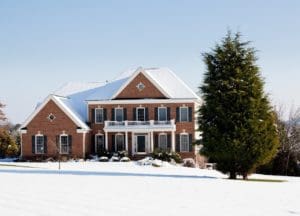Few homeowners enjoy the task of shoveling snow off their driveways. However, when the snow falls, it’s a task that must be done for safety’s sake. And in Colorado you can get snow as early as September and as late as May — you could have a lot of mornings that see you getting up early to shovel or fire up the snow blower.
The alternative is a heated driveway system. Find out everything you need to know about these systems.
Basics of Heated Driveway Systems
A heated driveway is essentially a radiant heat floor for the outdoors. However, rather than just heat an area, heated driveways get warm enough to melt snow. They’re best used to melt the snow before it gets a chance to accumulate, though they are effective at melting some accumulation. Contractors install the system so it connects to your house, which is where you activate it.
Heating Methods
As with radiant heat floors, contractors have two options for how to heat your driveway. The simpler system runs on electricity. It consists of a mat made of heating cables woven into a grid pattern. The contractors install this mat under the surface of the driveway. When you turn it on, the electric cables heat up.
The other system runs on hydronics. The contractors install tubing under your driveway’s surface. The tubing hooks up to a boiler, which is typically housed in the garage. The boiler heats water, which mixes with a non-freezing solution similar to antifreeze. This solution circulates through the tubes to heat up the driveway.
The electric system is easier to install, especially for retrofit operations. However, the system can be a drain on electricity. The hydronic system is a little more complicated, but it’s usually more budget-friendly to run.
Retrofit of an Existing Driveway
Heated driveway systems are easiest to install in new-build constructions. They’re also easy to install if you’re replacing your existing driveway.
However, you do have the option to retrofit your existing driveway. If you choose the electric mat system, the contractors can make cuts into your driveway, lay the cables, and cover them back up with a new layer of pavement. If you choose the hydronic system, they have to drill holes large enough to thread the pipes through.
Pros and Cons of Heated Driveway Systems
The main disadvantage of such systems is cost. They can cost between $12 and $21 per square foot to install. The price may be higher if the contractors are retrofitting an existing driveway. They can also be a bit pricey to run.
The obvious benefit of a heated driveway system is you don’t have to shovel the snow. This fact saves the average homeowner time and effort. However, these systems are also good for people of differing abilities and the elderly who might otherwise have to hire contractors for snow removal.
Radiant heat outdoor slabs have been in use in commercial settings, such as restaurant walkways, for years. The reason for their popularity is they also keep people safe. Even a light coating of snow or ice can cause dangerous slip-and-fall accidents, especially if the area has any slope. Heated driveways also tend to last longer since they’re not subject to the heat-thaw cycle.
Other Considerations for Heated Outdoor Pavement
These heating systems aren’t for your driveway alone. They can be installed under any kind of pavement, including concrete, asphalt, stone pavers, and even ceramic tile. Therefore, the heating system is appropriate for walkways, decks, and patios, too.
However wide-ranging your system, you’ll need to decide on the method of control. You can choose between manual and programmable. With manual systems you have to flip the switch when you see the snowfall. Programmable systems allow you to set up an outdoor thermostat to automatically start the heating based on temperature and moisture readings.
A heated driveway system requires little maintenance or repair work to last 20 years or more. You can save a lot of time, effort, and money on snow removal. Call Steele Bros Heating, Inc. to explore your options for such a system.

